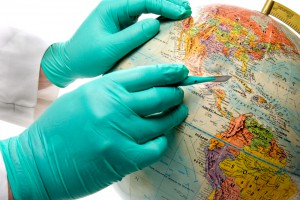
Cost-effectiveness ratios for many surgical procedures are comparable to those for accepted global public health strategies.
Traditionally, global health initiatives have focused on infectious disease or HIV/AIDS outreach. However, more recent data, including a 2012 study in The Lancet, show a growing global burden of noncommunicable diseases, such as cancer, that require surgical treatment.
Surgical disease was previously thought to comprise at least 11 percent of the total global burden of disease, but the Lancet paper showed approximately 25 percent of people requiring surgical assessment, based on a widespread survey in Sierra Leone. Additional research has revealed that up to 85 percent of pediatric patients in Africa have a surgical condition by the age of 15 years.
“However, the prevailing perception is that surgical care is too expensive and not cost-effective enough to bring to developing countries,” states Tiffany E. Chao, MD, a Paul Farmer Global Surgery Fellow in the Plastic and Oral Surgery Department at Boston Children’s.
Previous studies have evaluated surgery’s cost-effectiveness in distinct settings for specific conditions, but Chao and her colleagues conducted a systematic review of all such studies in developing countries. “While we acknowledge that surgery is still expensive in terms of resources, we showed that it was still cost-effective,” Chao notes.
To calculate cost-effectiveness, the researchers used disability-adjusted life years (DALYs), wherein one DALY is defined as the loss of the equivalent of one year of life at full health. Chao and her colleagues found that surgery in resource-poor settings has a median cost of $82.80 per DALY averted. The most inexpensive procedures included $5.37/DALY averted with trachoma surgery in Kenya and Benin, $7.48/DALY averted for cataract repair in Nepal and $7.91/DALY averted for circumcisions in Mozambique.
These cost-effectiveness ratios, Chao notes, are comparable to global public health strategies like BCG vaccination ($88.66/DALY) or medical regimens for ischemic heart disease ($897.04/DALY), and are far more cost-effective than HIV treatment ($1,198.86/DALY).
Based on the varied research that was reviewed—spanning multiple countries and methods—the researchers concluded that surgery can be cost-effective to very cost-effective, which provides “a strong argument for the scale-up of surgery in today’s global health movement.”
“Despite the heterogeneity of study quality and design—which again, varied greatly—nearly all the studies found that surgery is cost-effective,” Chao says. “While it’s hard to compare expenses across countries, the take-home message remains that bringing surgery to these under-served areas of the globe is cost-effective.”
This research was first presented at the 14th annual M. Judah Folkman Research Day at Boston Children’s Hospital.






